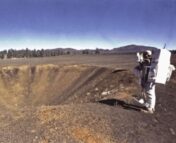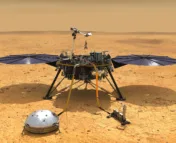Title: Spectral Diversity of Rocks and Soils in Mastcam Observations Along the Curiosity Rover’s Traverse in Gale Crater, Mars
Authors: Melissa S. Rice, Christina Seeger, Jim Bell, et al.
First Author’s Institution: Department of Geology, Western Washington University, Bellingham, WA, US
Status: Published in Journal of Geophysical Research: Planets [Open Access]
This bite is cross-posted from our geology sister site, Geobites. The original post from February 9, 2023 can be found here.

Emma Harris
I am a PhD researcher at the Natural History Museum and Imperial College London studying the geology of Mars from orbital imagery with a focus on Mars rover landing sites. In my spare time I like netball, horse riding, and listening to too much Taylor Swift.
On the 28th January 2023 NASA’s MSL Curiosity rover team confirmed the rock ‘Cacao’ as an iron-nickle (Fe-Ni) meteorite on the surface of Mars. Curiosity captured images of a silvery-grey rock, very distinctive among the beige-red sedimentary landscape it is currently exploring. Cacao is a ‘float’ rock, meaning is it not embedded within the bedrock and is not where it formed. Float rocks are common on Mars, but many can be traced back to the upper ledges of slopes they have fallen from, or as ejecta from a nearby impact. Cacao has joined a special group of float rocks that are distinct in appearance, genetic composition, and origin.
The MSL Curiosity team imaged and analysed the meteorite using MastCam cameras and ChemCam lasers in order to study the composition of the space rock. Although these particular results have not yet been published, similar Fe-Ni meteorites have been identified on the surface of Mars by Curiosity and other rovers! In 2005, NASA’s Opportunity rover found the first ever meteorite on another planet named ‘Heat Shield Rock’. In 2006, Opportunity’s twin rover Spirit found a meteorite named ‘Allan Hills’. In 2014, Curiosity found its first meteorite named ‘Lebanon’, and again in 2016 with ‘Egg Rock’.

A 2022 paper by Melissa Rice and co. on the MSL team describes the spectral diversity of rocks seen within the rover’s traverse. Spectral profiles are created by analysing the reflection and absorption across the electromagnetic (EM) spectrum using lasers. Every material has a distinct EM spectrum, so analysis of the spectral properties of rocks can allow the identification of their composition. The meteorites seen throughout the rover’s traverse all have spectral profiles that trend away from the norm – they are Fe-Ni meteorites!

Iron meteorites are one of 3 types of meteorites: iron, stony-iron, and stony. Fe-Ni meteorites represent the inner core of larger asteroids that had a core, mantle, and crust and were then impacted and torn apart. The iron core separated into iron meteorites that are able to tell us about the early formation of the solar system. Fe-Ni meteorites are the most common meteorite to find on the surface of Mars, as they look very distinctive amongst the reddish bedrock upon which they lie. Iron is also a resistant material that can survive erosion for much longer periods of time. Curiosity is likely to continue to discover these beautiful space rocks on Mars.
Curiosity is currently exploring a sulphate-rich region of Gale crater that sits upon a clay-rich environment meaning the rover has possibly driven over the rocks that were laid down in the global transition from neutral to acidic aqueous environment. This transition zone could hold the secrets to the past global climate changes on Mars, and help us answer the biggest question: was there ever life on Mars? Follow along with the mission here!
Featured image credit: ‘Cacao’ meteorite in Gale crater, Mars – MastCam mosaic comprised of 19 images. NASA/JPL-Caltech/MSSS.




